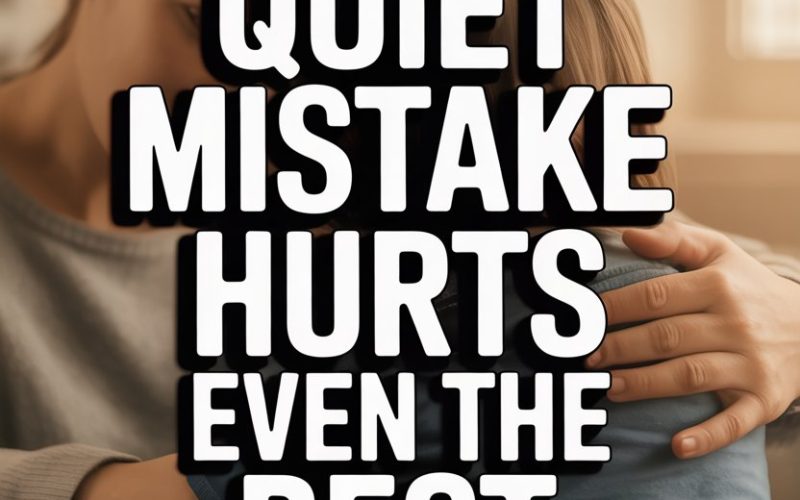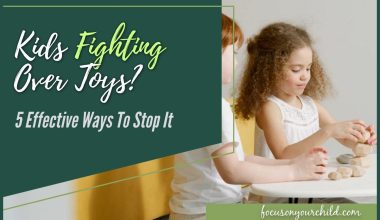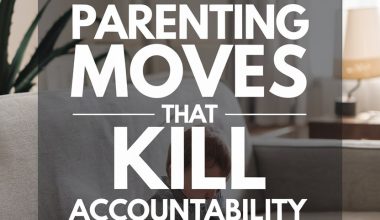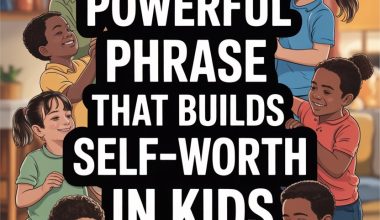Ever feel like you’re constantly juggling plates, only to notice one’s been wobbling in slow motion for about a decade?
Most parents have a radar for the big blunders—yelling, bribing with chocolate, accidentally teaching the toddler “bloody hell.”
But there’s a sneaky little mistake that even the all-star parents make. It whispers, not shouts. And it chips away at what matters most.
Time to shine a light on the quietest culprit in the parenting playbook.
The Silent Saboteur: Emotional Dismissal
Here’s the scene: You’re multitasking dinner, deadlines, and a child who’s come home heartbroken because someone wouldn’t sit with her at lunch.
You scoop her up, squeeze her tight, and—because you love her more than your own sleep—you say, “Don’t worry, sweetie. It’s not a big deal. You’ll make new friends tomorrow!”
Sounds loving enough, right?
Actually, this is what the experts call emotional dismissal. And it happens in thousands of homes every hour. The intention is comfort. The effect? Not so much.
What’s the harm in brushing off the little stuff? Turns out, quite a bit.
Research shows kids who hear their feelings are “no big deal” often grow up confused about their own emotions, less skilled at coping, and more likely to clam up when it counts.
Emotional dismissal is quiet, almost invisible. But it packs a punch.
Why Good Parents Miss It
Busy parents are wired for action. Problem shows up, solution gets offered. Child cries, we rush in with reassurance, distraction, or—on a champion day—a joke about farts and unicorns.
The reason this misstep flies under the radar? It looks a lot like caring.
Who wouldn’t want to sweep away a child’s pain with a cheerful “You’re fine!”? No one enjoys seeing their kid upset—especially in the queue at Tesco with an audience.
But here’s the kicker: well-intentioned minimising can make children feel unseen, misunderstood, or even ashamed of their feelings.
It’s not about intent. It’s about impact.
How Emotional Dismissal Sneaks Into Everyday Life
It wears a thousand disguises:
- “You’re okay. Don’t cry.”
- “Stop being silly, there’s nothing to be scared of.”
- “It’s not that bad. You’ll get over it.”
- “You don’t need to feel sad about that.”
Most parents have said these things. Sometimes before breakfast.
It isn’t just the ‘negative’ emotions, either. Celebrating a scraped knee for its bravery instead of letting the tears flow is another flavour of the same pie.
Each time, the hidden message is that certain feelings are inconvenient, embarrassing, or wrong.
Why This Hurts More Than You Think
Children take their emotional cues from us. When we tell them “It’s no big deal,” what they hear is: “My feelings must be wrong. I’d better hide them.”
Over time, that child learns to bottle up big emotions. Frustration, sadness, even excitement—corked like a bottle of fizz in a forgotten corner of the fridge.
The result? It doesn’t just vanish. Emotions have a habit of popping out in other ways: headaches, tantrums, anxiety, or even aggression.
One study found that dismissing children’s feelings predicted more difficulties with emotional regulation and social relationships.
Not exactly the stuff of Instagram highlights.
Why We Do It (And Why It’s Not All Bad News)
Before you start a guilt spiral, take a breath. Emotional dismissal is often the byproduct of love and sheer exhaustion.
You’re trying to protect, soothe, and patch up small wounds as quickly as possible.
Sometimes, it’s about getting through the supermarket shop before a meltdown over the wrong brand of cereal. Sometimes, you just want to shield them from pain you remember all too well.
The good news? Kids are wonderfully resilient. Tiny course corrections can make a huge difference.
Spotting the Warning Signs in Your Own House
Catch yourself thinking, “He’s just being dramatic”? Notice that urge to sweep away a teen’s breakup like it’s confetti? These are the breadcrumbs.
Other clues:
- Your child shies away from talking about tough days.
- They clam up when asked how they’re feeling.
- You find yourself offering solutions before hearing the whole story.
- The phrase “Don’t worry about it!” is on a loop.
Noticing these isn’t failure. It’s the first step to rewiring.
How to Stop the Quiet Mistake—Tonight
Ready for a practical shift? You don’t need to schedule a family feelings summit or start narrating your every fleeting emotion.
Try this instead: Pause. Listen. Name what you see.
Your child says, “I’m scared about the spelling test.” Resist the urge to say, “Don’t be silly, you’ll ace it!” Instead, you might reply, “Tests can feel scary. Tell me more about what’s worrying you.”
This isn’t permission for wallowing. It’s simply standing beside your child in their moment, so they don’t feel alone with big feelings.
Validation doesn’t magnify pain. It makes it manageable.
What Validation Sounds Like
If the words “emotional validation” make you picture a therapist’s office and a box of tissues, keep reading. This can be everyday language.
- “That sounds really tough.”
- “I can see why you’re upset.”
- “You wish things were different, huh?”
- “It’s okay to feel sad about that.”
Even a simple “I hear you” is powerful. You don’t need to agree with the feeling to acknowledge it.
And if you’re worried that this will turn your child into a puddle of whinge, relax. Research shows kids who are emotionally validated bounce back faster and cope better long-term.
When You’re Out of Patience, Try This
Let’s be real: Some days, your own nerves are frayed before the kettle’s even boiled.
If you can’t summon a soothing monologue, try a small gesture—an arm around the shoulder, a quiet “I know today was rough.” Or even, “I’m tired too. Maybe we can snuggle and chat about it later?”
Sometimes, presence matters more than words.
Teaching Kids What to Do With Big Feelings
Validating emotion isn’t the end of the story. Kids need to learn what comes next. That’s where coaching comes in.
Once the storm has passed—or the sobbing has slowed—you can help kids brainstorm ways to handle their feelings.
“Would a drawing help?” “Do you want to shout into a pillow?” “Maybe a walk together would help us both.”
Children who feel seen are more likely to try new coping skills. No “solution” necessary right away. Just a bit of curiosity and support.
What About Positive Emotions?
Don’t forget the other end of the spectrum. Sometimes, children’s joy, excitement, or wild enthusiasm gets squashed too (“Calm down, you’re being too loud!”).
Emotional validation isn’t just for the sad stuff. Celebrate the highs, too—even if it means tolerating a little extra volume or wild dancing in the living room.
Modelling Matters More Than Perfection
If you’re the type to bottle things up (hello, British reserve!), showing your own feelings can feel awkward. Yet, modelling is one of the best tools in your kit.
Try admitting, “I’m feeling stressed about work, so I might be a bit grumpy tonight,” or “I’m excited for your game and my tummy has butterflies!”
No need to overshare. Just enough to show that adults have feelings too—and they’re not an emergency.
The Payoff: Stronger Connection, Resilient Kids
Stepping back from emotional dismissal builds trust. Kids learn their feelings won’t get them sent to their room, ignored, or laughed off. That safe space is the bedrock of resilience.
Children who feel understood are less likely to explode, withdraw, or hide stuff. They’re more likely to seek your support for the big things when they’re older.
That’s the secret sauce: Not fixing every problem, but being there, ears open, for whatever comes up.
When You Need Extra Support
Sometimes, big emotions or behavioural shifts mean there’s something more serious going on.
If your child is struggling to function, it’s always smart to check in with a school counsellor, GP, or therapist. No shame, ever, in asking for backup.
Parents need support too. If your own upbringing makes this stuff hard, or you find yourself triggered by your child’s feelings, reaching out for help is a sign of strength.
Tiny Tweaks, Big Rewards
The quiet mistake of emotional dismissal can trip up even the most loving families.
But here’s the real kicker: Small shifts—pausing, listening, validating—can change the whole tone of your house.
Tonight, when your child’s feelings bubble up (and they will, right after you’ve sat down), try letting them be.
Listen, name it, hold space, and know you’re raising a child who’ll grow up knowing every part of themselves deserves a seat at the table.
No cape required. Just a willingness to hear the quiet stuff—the little feelings that matter a lot.





